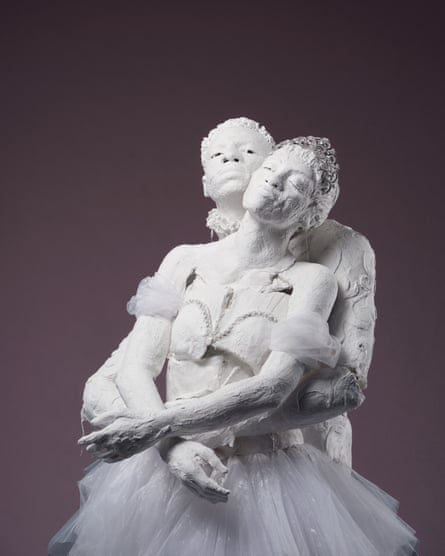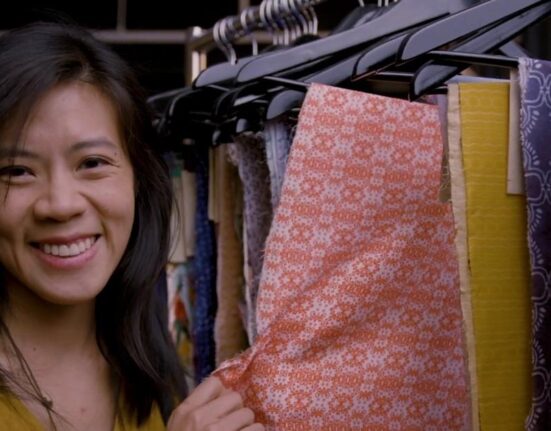It begins with barre. The young girl’s left hand grips the bar, her right hand in first position, her tutu adorably upright, while she inquisitively, and somewhat nervously, looks at her reflection in the mirror.
It’s a process every dancer starts with, and it’s this image that visitors see first at Beauty Must Suffer, an exhibition by US-born artist Karon Davis at Salon 94 in New York. The show that traces the whole process of ballet: from the training to the final bow, while simultaneously revealing the pressure to live up to an idealised image – as well as the passion and resilience integral to life as a dancer.
Let’s go back to the young girls. They’re eight or nine, with sweetly developing bodies that contrast with glassy piercing eyes that speak of the focus and discipline needed to succeed. From an early age, ballet training is rigorous, painful and exhausting – all in order to impress an outside world that will later watch you dazzle, seemingly effortlessly, on stage.

Davis knows what lies behind the perfect surface. “I came out of the womb and my parents handed me a tap shoe and ballet shoes,” she says. She was a trained dancer before switching to film-making. Her parents met while dancing – ballerina Nancy Bruner and entertainer Ben Vereen. Her sister, Naja, who died aged 16, was an aspiring ballerina too. The harsh realities of pushing one’s body beyond its limits for the sake of performance were part of Davis’s upbringing. “Beauty must suffer,” her mother would say.
Davis’s Black figures, covered in white plasterdust to allude to the Eurocentric beauty standards demanded by the industry, chart both the ages and stages of a ballerina, and the emotional and physical effects. One very moving sculpture depicts a teenage girl who sits in the corner of the room, quietly and solemnly scrubbing (“pancaking”) her pink satin ballet slippers with brown pigment to match her skin tone. Her pink pile of slippers vastly outnumbers the brown one to outline how much more labour she has to do – and showing what it takes to be a person of colour in a predominantly white industry. Indeed, it took until 2018 for the major makers of ballet slippers to create colours for different skin tones; still today people are petitioning for more shades to be available.
Then there’s the ballerina pristinely dressed in a bejewelled costume and tiara, who is smoking a cigarette. It’s the dichotomy of beauty and harm, the glamour of the performance and the anxiety backstage, as she feeds her exhausted body a cigarette to suppress her appetite.
Up on the top floor there is a “sculpted ballet” that pays homage to the history of dance, with poses taken from famous ballets. It’s the epitome of beauty and grace, as if the sweat and pain we’ve seen in the other rooms has been forgotten entirely. “Every time a dancer steps on stage it is birth. There is a connection with a higher power that the audience is just a spectator of and has the privilege to witness. The stage is the goal; it’s the dancer’s soulmate,” Davis told me.
We follow the story of Echo and Narcissus. At first, we meet them in a pose inspired by Julius Wenzel Reisinger’s Swan Lake, intertwined in each other’s arms. Then we see them evoking Alvin Ailey’s Revelations, with Narcissus holding up Echo as though she were flying.
after newsletter promotion
Then tragedy unfolds. Echo, struck by a curse that prevents her from conversing with her lover, descends into disintegration. Mirroring Sir Frederick Ashton’s Marguerite and Armand, she covers her mouth, while Narcissus reaches out to a face that is no longer there. In the next few sculptures, the figures become too thin; their bodies erode; their feet are flat as opposed to en point; the diamonds that once adorned their dresses vanish. The finale is not one of love nor beauty, but of dissolution. Echo – in a pose inspired by Martha Graham – is surrounded by shells that have fallen from her body.
In an exhibition that bears witness to the spirit of the dancer and the reward of labour, Davis makes us realise that something can be as painful as it is spectacularly beautiful. It’s a reminder of the people who work to exhaustion in order to please us. It also urges us always to look beyond what we see: to understand the whole picture, from every perspective, so vital changes can be made to protect people.






